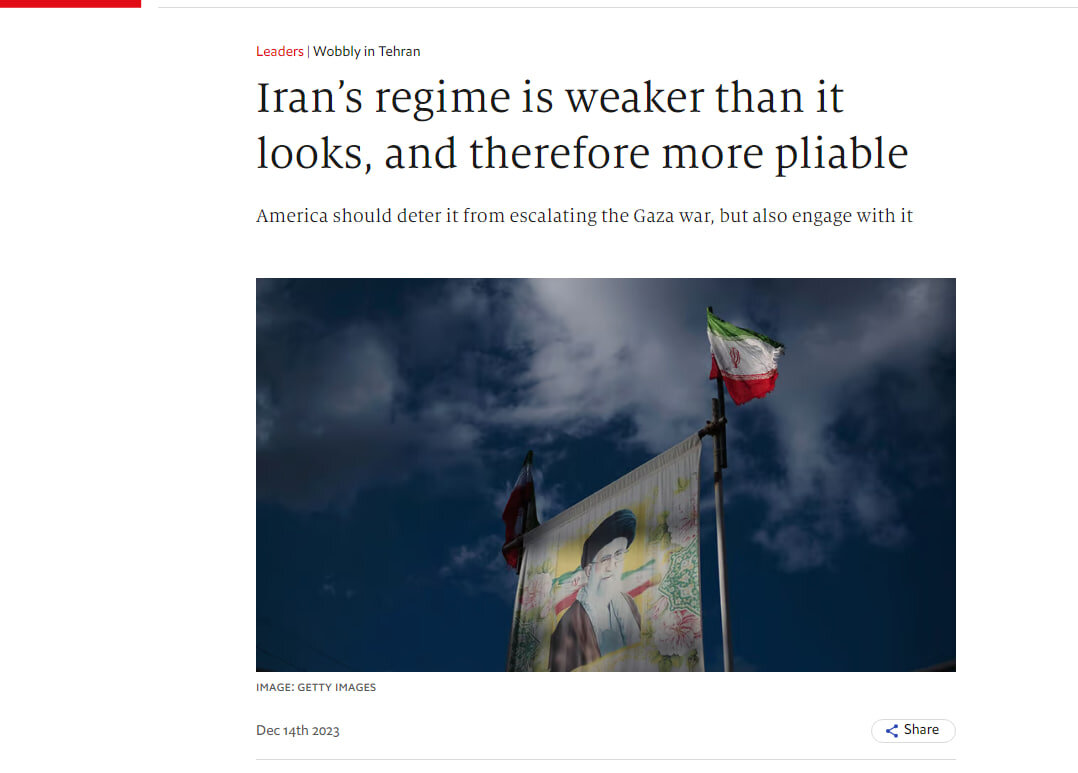CPR of a mass murderer

TEHRAN- “Iran’s regime is weaker than it looks, and therefore more pliable” is the title of an article posted on the Economist website on December 14.
Israel's destructive attacks on Gaza and the ongoing conflict between Israel and Palestine extend beyond the battlefield, with the media playing a significant role in this war. While Israel continues mass killings in Gaza without fearing the consequences of its actions, the majority of the Western media supports this regime with all its might and any dissenting voice is suppressed on the charge of being anti-Jewish. Throughout the Israel-Palestine conflict, the Economist has consistently favored Israel, framing the conflict as a battle between Israel and Hamas, thus reflecting the broader bias prevalent in Western media. The Economist's more aggressive and less professional approach allows readers to see the general direction of Western media without retouching.
Since October 7, the Western media has heavily focused on highlighting the differences between Palestinian resistance forces, Iran, Hezbollah, and other active entities within the resistance axis. In this article, the author underscores the difference between Iran and the resistance forces, asserting that despite Iran's perceived increase in strength, it is not so. The author states, “Although Iran's client militias have joined the battle to defend Hamas in Gaza, their efforts have been half-hearted”. In fact, a strip in the land of Palestine is under a complete siege from the sea and the land, and even the entry of food is difficult, and hospitals and their infrastructures are bombarded by Israel with bombs sent from the West, and no one has been able to help Gaza in this situation. Furthermore, the author asserts, “Iran has been boxed in by America, which has sent two aircraft-carrier groups to the Middle East. This seems to have deterred Iran from ordering Hezbollah, its Lebanese proxy, to escalate the war over Gaza. It knows that anything more than token attacks on Israel would risk a devastating response.” However, this perspective misconstrues the dynamics at play. In reality, American bases in the region are targeted by missiles from the resistance forces, and Hezbollah is actively engaging in targeted attacks within occupied territories. Additionally, American naval vessels have struggled to secure shipping routes, while Israeli ships remain vulnerable to Yemeni forces' surveillance.
At the end of the article, the author suggests that “America should continue to focus on de-escalation. That means continuing to show strength. It should maintain military pressure on Iran and its proxies, and stand up an international coalition to deter Yemen’s Houthis from further attacks on commercial ships in the Red Sea.” In this suggestions, the author has overlooked some of the clear realities of today's world. For several years, the United States has started looking to the East and has shifted its focus from the West Asia region. Whether United States wants it or not, China has gained power and United States has already lost some of its sphere of influence in the world. The Ukraine war is raging, and America is still committed to supporting this country, and the Zionist regime, even without war, is suffering from many internal problems that cannot be solved with American weapons and financial supports. Economist writers can repeat to themselves that Iran is no longer strong, but this perception does not change this reality: the fate of wars and crises in West Asia is no longer determined by the movement of American naval forces, and such analyses cannot change the spirit and face of the Zionist regime.
Leave a Comment